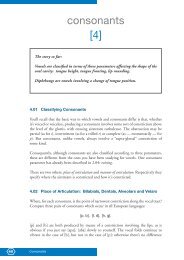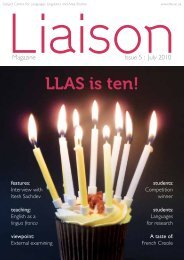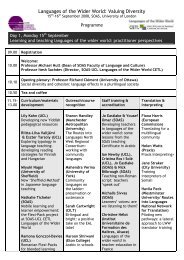PHONETICS MANUAL.indd - HumBox
PHONETICS MANUAL.indd - HumBox
PHONETICS MANUAL.indd - HumBox
You also want an ePaper? Increase the reach of your titles
YUMPU automatically turns print PDFs into web optimized ePapers that Google loves.
for instance. As we’ll see in more detail later, for both these sounds there is a constriction<br />
of the airflow just behind the upper front teeth. The difference between them is that<br />
[s] is voiceless (vocal folds held apart in the Fig. 2 position and the airstream able to<br />
pass between them unhindered) whereas [z] is voiced, with the vocal folds in the Fig.<br />
4 position and consequently in vibration. You should be able to spot the absence or<br />
presence of voicing easily enough if you say [s] ... [z] ... [s] ... [z] loudly several times in<br />
alternation. The difference becomes even more obvious if you place your fingers firmly<br />
over your ears while doing so.<br />
The same relationship exists between the th in thin and the th in this. This time,<br />
unfortunately, the spelling doesn’t show any difference. But by repeating these two<br />
words in alternation you should be able to tell that in the case of thin we have a<br />
voiceless th and in the case of this a voiced one. The phonetic alphabet uses a separate<br />
symbol for each: [T] (read “theta”) for the th of thin and [ð] (read “eth”) for the th of<br />
this. [ð] is also sometimes called “thorn” (from the name of a letter of the Old English<br />
alphabet).<br />
Yet another voiceless/voiced pair is [p] and [b]. Try to say [apa] and [aba] in alternation.<br />
In both cases there’s a momentary blockage of the airstream between the lips when the<br />
consonant is made. What makes the difference between them is voicing (present for<br />
[b], absent for [p]).<br />
In fact almost all consonants come in voiced and voiceless pairs — an very efficient<br />
use of a single feature (voicing) in order to double, at a stroke, the number of available<br />
sounds.<br />
Exercises<br />
1. Choose an appropriate term from the list, and insert it into one (or more) of the<br />
gaps in the paragraph that follows:<br />
bronchi<br />
glottis<br />
larynx<br />
lungs<br />
trachea<br />
vocal folds<br />
The _______________ supply the air for almost all speech sounds. Air passes from<br />
them into the _______________, one from each of the two ________________, and<br />
these two airstreams merge in the _______________, a short tube situated in the<br />
lower part of the neck. On top of this is a valve known as the _______________.<br />
Here the supply of air to the throat and mouth is controlled by opening or closing<br />
the _______________ the gap between the two ________________. In ordinary quiet<br />
breathing the _______________ is open; for swallowing it is closed in order to protect<br />
the _______________. A noteworthy evolutionary adaptation in humans allows voice<br />
The Vocal Tract<br />
7






